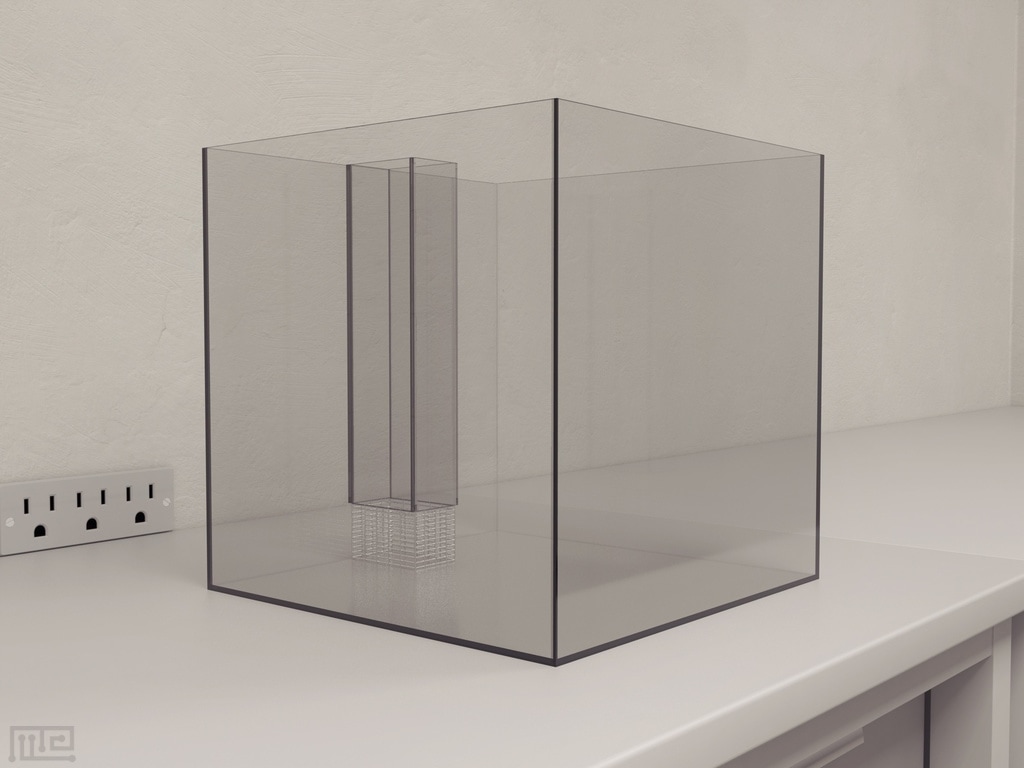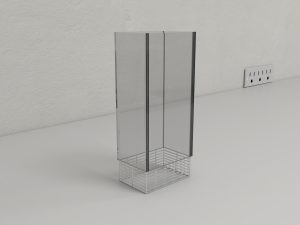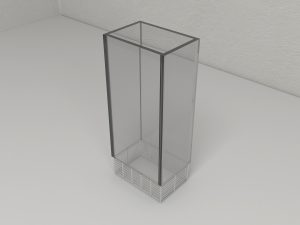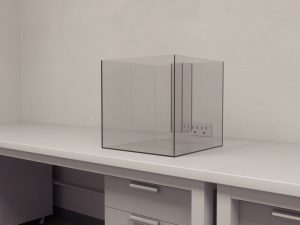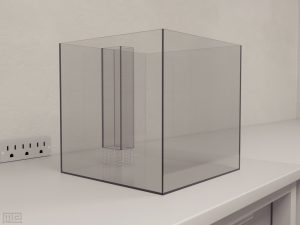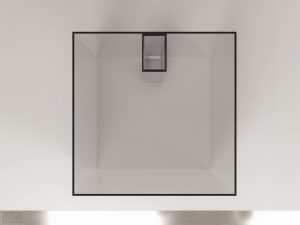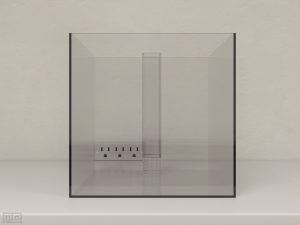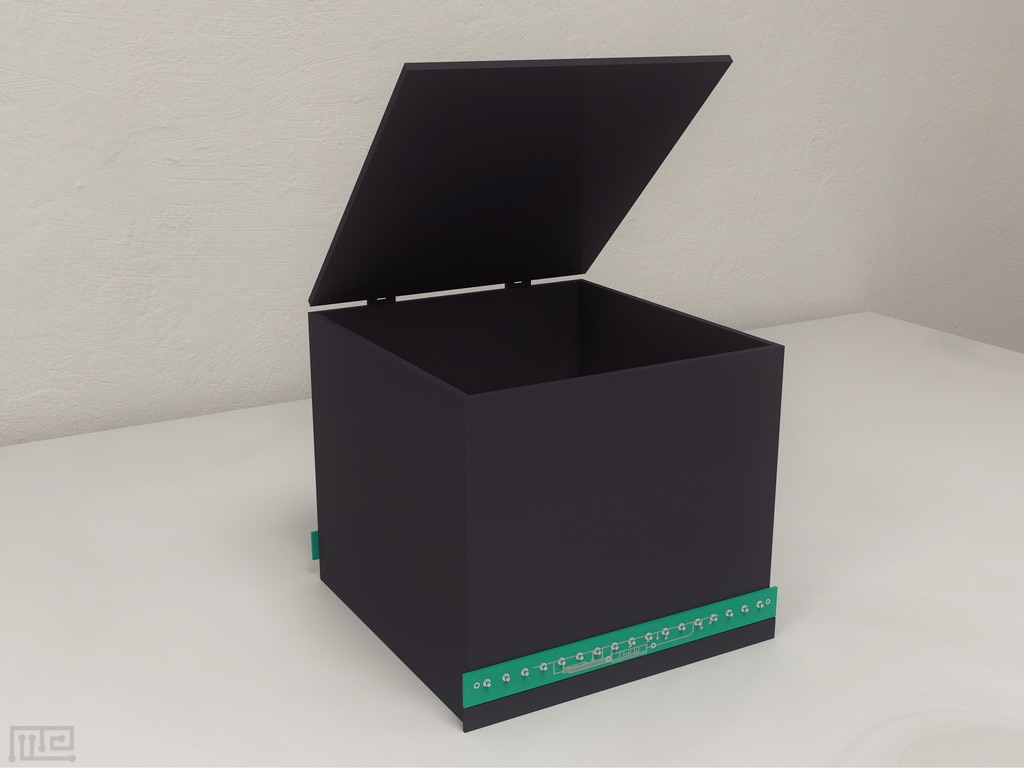Description
The social defeat test allows for study of recurrent defeat and is often used in the assessment of psychiatric compounds. The repetitive exposure encourages anhedonia, social avoidance behaviors, and anxiety and although relatively new (developed in 2006), is seen as a simple yet powerful model of social interaction. The MazeEngineers social defeat apparatus comes with two social defeat cages, an arena, and a clear divider for use in the home cage. Additional cages or modifications can be made upon request.
Price & Dimensions
Mouse
$ 1290
Per Month- (1) Total Arena Size: Width: 42cm, Length: 42cm, Height: 42cm.
- (2) Mesh Enclosure: Width: 10cm. Depth: 6.5cm. Height: 42cm.
- (1) Divider: Width: 0.5cm Depth: 42cm Height: 15cm
Rat
$ 1690
Per Month- (1) Total Arena: Width: 68cm, Length: 68cm, Height: 68cm.
- (2) Mesh Enclosure: Width: 17cm. Depth: 11cm. Height: 68cm.
- (1) Divider: Width: 0.5cm Depth: 68cm Height: 25cm
Documentation
Introduction
Standardized Model for Repeated Social Defeat Stress (Golden et al., 2011), or social defeat protocol is an extensively applicable paradigm which assesses the underlying mechanisms of affective-like disorders. (Johren O et al., 1994).
Social defeat protocol is providing new facts about the molecular basis of affective disorders to help in the formulation of novel antidepressant treatment approaches. (Berton O, Nestler EJ, 2006)
It also helps in comparing the efficacies of traditional serotonin-reuptake inhibitors and novel compounds. In this model, intruder mice are repeatedly subjected to bouts of social defeat by a larger and more aggressive resident mouse. (Kudryavtseva et al., 1991; Koolhaas et al., 1997).
Although the defeat lasts for about 5-10 minutes, the defeated mouse is continuously subjected to psychological stress through sensory interaction with the resident during the course of the experiment.
After repetitive exposures to bouts, rats and mice depict a wide range of depression-like phenotype manifested by anhedonia, social avoidance behaviors, and anxiety. (Rygula R et al., 2006; Berton et al., 2006)
This paradigm was developed by Berton et al., 2006. It is a modified version of sensory contact model (SCM) developed by Kudryavtseva et al., 1991, which elaborated the consequences of chronic social conflicts in rodents.
Apparatus & Equipment
The apparatus consists of a transparent home cage approx. 26.7 cm (w) × 48.3 cm (d) × 15.2 cm (h) equipped with steel-wire tops. The base of the cage is made up of hard woodchip bedding.
The apparatus is divided into half by a transparent perforated Plexiglas approx. 0.6 cm (w) × 45.7 cm (d) × 15.2 cm (h). A stopwatch for timing defeat sessions manually is also used. (Golden et al., 2011)
Besides the home cage, the apparatus also consists of an open field arena for social interaction tests crafted from opaque glass approx. 42 cm (w) × 42 cm (d) × 42 cm (h) and removable wire-mesh enclosures(usually two in number marked as ‘target only’ and ‘no target’) fitted in Plexiglas (10 cm (w) × 6.5 cm (d) × 42 cm (h). (Golden et al., 2011)
The activity inside the social interaction arena is recorded with a video tracker such as Noldus Ethovision XT or ANY-Maze.
Related Apparatus
Training Protocol
The purpose of the social defeat protocol is to evaluate affective-like behaviors in rodents in a control vs. disease model/intervention group, by assessing their behavior in the social interaction arena.
Social defeat stress
A day before the first social defeat stress, the resident mouse is introduced in one compartment of the divided home cage.
On the first day, place the intruder mouse directly in the resident mouse’s compartment for 5-10 minutes. After the confrontation, remove the intruder from the resident’s compartment and transfer it to the opposite compartment within the home cage for the remainder of the day. The same procedure is repeated for ten consecutive days.
An identical setup is employed for control group kept in pairs; one on each side of the home cage. The compartments of the control mice are regularly swapped, but they are not allowed to come in physical contact with each other.
After 10 days of social defeat, the intruder mouse is transferred to a conventional cage alone with ad lb. supply of food and water.
Mostly, the social interaction testing is carried out about 24 hours after the last social defeat.
Social Interaction Testing
Pre-training for Social interaction testing
For habituation, the defeated mouse is introduced in the social interaction arena 1-hour before testing. The testing room is alienated from external sound, and the entire test is followed under red-light conditions.
Evaluation of affective-like behaviors
Social interaction test is segregated into two phases comprising of 150 seconds each with the resting duration of 30 seconds between phases.
For social interaction test, a new target aggressor mouse is used in order to minimize the effect of habituation of the intruder with the resident mice.
During the first phase in the absence of the target mouse, defeated mouse is introduced in the rear center of the social interaction arena facing the empty wire-mesh enclosure and the activity is recorded.
After 150 seconds, the defeated mouse along with the ‘no target’ wire-mesh enclosure is removed from the arena. Within the resting period, the target mouse is secured in the ‘target only’ wire-mesh enclosure and placed within the arena.
Afterward, the defeated mouse is removed from the home cage and placed in the same position facing the wire-mesh enclosure.
The movement of the defeated mouse is recorded with a video tracker. At the end of the experiment, both mice are removed, and the apparatus is cleaned thoroughly.
Modifications
Social defeat protocol has the inherent capacity with which it can be easily modified.
A significant modification of the social defeat protocol is the development of the ‘microdefeat.’ In a ‘microdefeat’ protocol, the intruder mouse is subjected to diminished levels of social defeat that consists of three 5-min social defeats given successively within a day separated by 15 minutes of rest between each bout.
Social interaction is then tested after a day. The mouse doesn’t produce any significant avoidance after ‘microdefeat.’ (Krishnan V, et al., 2007)
Sample Data
The animals are either referred as susceptible or resilient depending upon their behavior in the interaction test arena.
Susceptible animals develop significant social avoidance associated with the affective-like behaviors, whereas resilient animals fail to develop social avoidance. (Krishnan V, et al., 2007)
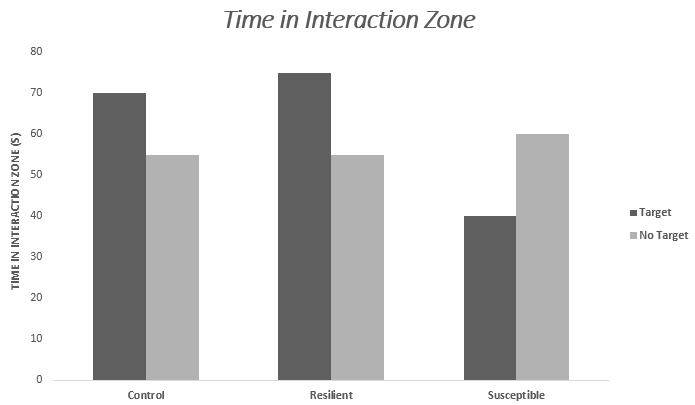
Strengths and Limitations
Strengths
Social defeat protocol has surpassed many related experimental approaches for studying depression. Most importantly, it has shown exceptional results as far as the predictive, etiological, discriminative, and face validities are concerned.
The behavioral syndrome induced by social defeat makes this model unique as it is helpful in examining the differences between depression and anxiety associated behaviors.
As different animals develop different stress-induced behaviors, the social defeat model becomes critical when resilience and susceptibility to stress are under consideration. (Nestler and Hyman, 2010)
Limitations
The most substantial drawback of utilizing the standardized social defeat protocol include inherent variability presented by external factors such as the aggression levels of the mice and a modest investment in terms of time.
Another drawback of the social defeat paradigm is the inability to respond to acute administration of antidepressants, unlike other stress models that respond equally to both acute and chronic administration of antidepressant.
However, it responds to chronic administration of antidepressants efficiently. (Tsankova NM, et al., 2006)
Summary and Key Points
- Social defeat protocol evaluates the underlying mechanisms of affective-like disorders.
- With the help of the paradigm, the efficacies of traditional serotonin-reuptake inhibitors and newer compounds can be compared.
- Home cages are employed for social defeat whereas an open field arena is utilized to perform the social interaction test.
- Social defeat protocol can be easily modified because of its inherent flexibility.
- This model has the discriminative ability to classify animals according to depression and anxiety-like behavioral domains.
- It maintains the four (predictive, etiological, discriminative, and face) necessary forms of the validity of a model.
References
Golden S. A., Covington Iii H. E., Berton O., Russo S. J. (2011). A standardized protocol for repeated social defeat stress in mice. Nat. Protoc. 6, 1183–1191. 10.1038/nprot.2011.361
Johren O, Flugge G, Fuchs E. Regulation of hippocampal glucocorticoid receptor gene expression by psychosocial conflict. Ann. NY Acad. Sci. 1994; 746:429–430.
Berton O, Nestler EJ. New approaches to antidepressant drug discovery: beyond monoamines. Nat. Rev. Neurosci. 2006; 7:137–151.
Berton O, et al. Essential role of BDNF in the mesolimbic dopamine pathway in social defeat stress. Science. 2006; 311:864–868.
Miczek K. A. (1979). A new test for aggression in rats without aversive stimulation: differential effects of d-amphetamine and cocaine. Psychopharmacology (Berl). 60, 253–259.
Kudryavtseva NN, Bakshtanovskaya IV, Koryakina LA. Social model of depression in mice of C57BL/6J strain. Pharmacol. Biochem. Behav. 1991; 38:315–320.
Koolhaas J. M., De Boer S. F., De Rutter A. J., Meerlo P., Sgoifo A. (1997). Social stress in rats and mice. Acta Physiol. Scand. Suppl. 640, 69–72.
Rygula R, Abumaria N, Domenici E, Hiemke C, Fuchs E. Effects of “f” on behavioral deficits evoked by chronic social stress in rats. Behav. Brain. Res. 2006; 174:188–192.
Krishnan V, et al. Molecular adaptations underlying susceptibility and resistance to social defeat in brain reward regions. Cell. 2007; 131:391–404.
Nestler EJ, Hyman SE. Animal models of neuropsychiatric disorders. Nat. Neurosci. 2010; 13:1161–1169.
Tsankova NM, et al. Sustained hippocampal chromatin regulation in a mouse model of depression and antidepressant action. Nat. Neurosci. 2006; 9:519–525.

